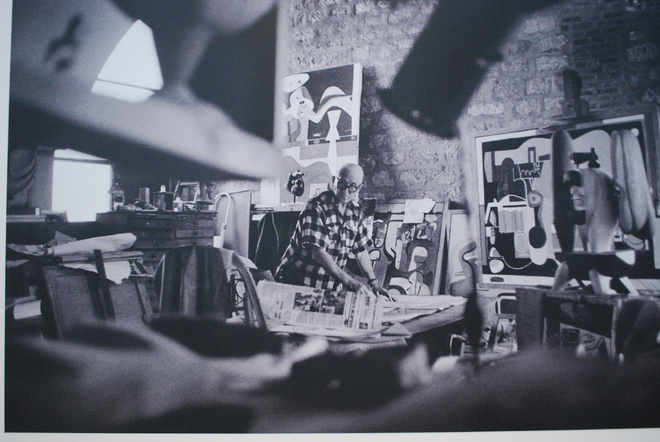
Le Corbusier at work in his office
B.N.Goswamy
I confess that I am writing this piece with a sense of bafflement. I am baffled because every now and then a chorus of wails goes up in our city: our ‘heritage furniture’ is being sold abroad; and everyone seems to take notice. Suddenly, names of auction houses are flashed in the media: names, incidentally, that no one had ever heard of before. Mouth-watering prices that ‘our’ tables and chairs and stools are fetching abroad are ferreted out and precisely listed.
RTI requisitions are filed, asking the agencies concerned to specify who did these ‘rare items’ belong to, and how were these ‘smuggled out’ of our land? Fingers, shaking with rage, begin being pointed; ‘responsibility must be fixed’ is the demand made in hectoring tones; vague suggestions are made that the country should approach the highest international agencies to stop this ‘plunder’. ‘National wealth is being looted yet again’, and ‘the administration sleeps’: that, in substance, is the theme of the chorus. The decibels vary from occasion to occasion, and the character keeps changing: from buzz and noise through uproar and clamour to cacophony. After a while, it subsides; but, another auction, and, raktabija like, it comes to life again.
I do not know what others think of this phenomenon. On my part, I am tempted to reflect on this a little.
Clearly, the reference here is to furniture that was designed at the time that the city of Chandigarh was being built: not necessarily by Le Corbusier himself but by his cousin, Pierre Jeanneret, or with reference to the work of another designer colleague of theirs, the gifted Charlotte Perriand, who had collaborated with the twosome as early as 1937. The furniture — from routine office chairs and tables to armchairs and ‘Judge’s chairs’ and sofas and fireside chairs — was conceived as only architects like them would: ‘minimalist and non-decorative’; combining ‘modern sensibility with traditional carpentry’; using the language of geometry. There was nothing 19th century about the furniture they designed — certainly not like the elaborate, hand-carved, items that the Maharajas used to fill their palaces with; not even like some of the innovative and delicate pieces that were once housed in the Viceregal Lodge in Shimla and later auctioned: these were functional pieces meant to be used by everyone from the highest to the lowest, and were produced by the thousand. Officers and clerks in government offices, teachers and students in universities and colleges, worked and sat on them for years. No label of ‘heritage’ was attached to these. Once a piece broke or became non-functional, it was discarded if it could not be repaired. I am certain many would recall the sight of piles of these chairs and tables dumped in corners or in balconies, waiting to be written off and auctioned. Office after office followed the routine: from government departments to courts, from the secretariat to hospitals, from universities to colleges. Nobody gave the whole matter a second thought. Till of course some shrewd and imaginative auction houses or furniture makers descended upon the land, began buying these tables and chairs at prices just a trifle above the price of wood, took them back to Europe, restored them, declared them as ‘heritage pieces’, and put them up for auction. The ploy worked. After all there was the association of famous names — Le Corbusier and Pierre Jeanneret — with them; after all these were hand-made pieces; and after all there would always be ill-informed, bargain-hunting, buyers: anywhere. The much-abused word ‘heritage’ was attached — by whom, no one knows — to these items of mass-made, commercially produced, furniture. And it travelled back to India, as things often do.
I am apt to be misunderstood. It is not that I am running down the designs, or questioning the genius of Le Corbusier or Jeanneret. There is elegance in many of those designs and some moving simplicity; some of them — like the ‘petit modele’ armchairs — can also legitimately be viewed as classics in this genre. The point simply is whether those items of furniture, produced in numbers without count, deserve to be designated as ‘heritage’. How are these part of our ‘heritage’, I would ask? Is the breath of great, hoary time upon them? Are the skills of which these are products lost forever? Is any of them a one-off piece? Is there the firm association of a great name with all of them? I recognise that an object does not have to be necessarily unique, one of a kind, to move into the hallowed category of ‘heritage’. The desk and chair that Le Corbusier or Jeanneret personally sat or worked on, or a very few selected items that recall their presence in our midst, should be seen as ‘heritage items’ and preserved, because of the strong personal association with them, but not every table or chair of that design becomes ‘heritage’. It is easy to cite examples. If the pair of thin-rimmed, round-shaped spectacles that belonged personally to Gandhiji is regarded as a ‘heritage’ item, it makes sense; but not every pair of thin-rimmed round-shaped spectacles — and thousands of the same kind must have been produced at that time by its manufacturers — qualifies. From India alone, the list can be long: the pen with which Jawaharlal Nehru signed the Constitution of India, the dhoti and turban worn by Swami Vivekanand, the kalghi of the great Guru, Gobind Singh, the ‘mu-e mubarak’ of the Prophet Muhammad. I remember the time I saw the desk that the great savant, Ananda Coomaraswamy, had worked on for years, as curator, in the Museum of Fine Arts at Boston, and remember being moved by the sight. A neatly calligraphed small brass plaque nailed to it told me that this was the great man’s desk. Nothing extraordinary about the desk, except of course for its association.
I am leaving out, because of space constraints, other aspects of the whole heritage question: what separates and elevates an object, a monument, a place, above others: age, history, uniqueness, the memory of lost skills, association? But surely one needs to pause and think a bit before getting into a tizzy — something that the media feeds with relishsinceit makes sensational, perhaps even ‘patriotic’, news — and beginning to lament the sale of our ‘heritage furniture’ in France, or wherever. If it was stolen, that is an issue: for theft is theft. If it was taken out illegally, then legal recourse is due. But if it was bought at open auctions, and no one still has been able to lay down what is ‘heritage’ about it, then should the noise not die down a bit?
For me the worrying thing is that when there is raucous noise, the ‘Administration’, feels under siege. ‘Solutions’ to the ‘problem’ begin pouring in; public men keep up the noise; ‘the Centre’, in a knee-jerk reaction, asks ‘the Administration’ to ‘do something about it’. The spiral keeps spinning out of control. I recall the time when there was even a formal move that all ‘heritage furniture’, wherever it was found – in offices, homes – in whatever condition, should be inventoried, stored in one place, and kept under strict guard.
For me, the natural question is: what, then? Turn that store into a museum of hundreds of identical chairs and tables and stools? Make a shrine of it? Allow it to rot over years, and then auction it at prices somewhat higher than those realised a generation ago? I confess I am unable to think that far.



























